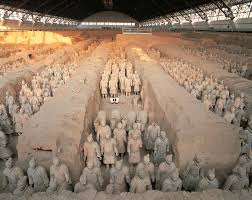
What Was Discovered Inside the Terracotta Army Tomb?
The Terracotta Army is one of the most significant archaeological discoveries of the 20th century, captivating the world with its sheer scale and artistry. While the army itself is impressive, the complex also houses an array of other finds that offer valuable insights into the Qin dynasty and ancient Chinese civilization.
An Army Frozen in Time
Nearly 200 accompanying pits have been discovered surrounding the mausoleum of Qin Shi Huang, the first emperor of China. These pits contain thousands of life-size terracotta figures meticulously arranged in battle formations.
- Terracotta Soldiers: The soldiers, each with unique facial features, hairstyles, and armor, represent the emperor's vast army. They are categorized into different ranks, including infantrymen, archers, charioteers, and generals, showcasing the military hierarchy of the Qin dynasty.
- Terracotta Horses: Alongside the soldiers stand hundreds of life-sized terracotta horses, equally detailed and lifelike. These horses, depicted in various stances and with elaborate harnesses, were intended to pull chariots and transport soldiers into the afterlife.
- Bronze Chariots and Weapons: The pits also contained remnants of bronze chariots, intricately designed and adorned with gold and silver. Alongside these chariots were a variety of bronze weapons, including swords, spears, crossbows, and arrows, demonstrating the advanced craftsmanship of the time.
Beyond the Army: Tombs and Architectural Remains
The vast property, spanning 56.25 square kilometers, encompasses much more than just the soldier pits. Over 600 sites have been identified within the area, including:
- Burial Tombs: While the emperor's tomb remains unexcavated, several accompanying tombs belonging to concubines and high-ranking officials have been unearthed. These tombs offer insights into burial practices and the social hierarchy of the Qin dynasty.
- Architectural Remains: The site also includes remnants of palaces, administrative buildings, and workshops, providing valuable information about the architecture, urban planning, and daily life during the Qin dynasty.
A Window into the Past
The discoveries made within the Terracotta Army complex offer a captivating glimpse into the reign of Qin Shi Huang and the grandeur of ancient China.
Q&A
1. What is the significance of the Terracotta Army?
The Terracotta Army is significant because it provides valuable insights into the military organization, artistry, and beliefs of the Qin dynasty, shedding light on a pivotal period in Chinese history.
2. Why was the Terracotta Army created?
The Terracotta Army was created to accompany Qin Shi Huang, the first emperor of China, into the afterlife. It was believed that the figures would protect him and allow him to rule with the same power and authority in the afterlife.
3. How many terracotta figures are estimated to be in the pits?
It is estimated that over 8,000 terracotta soldiers, horses, and chariots are buried within the pits surrounding the emperor's tomb.